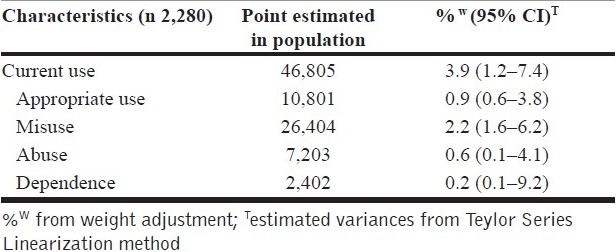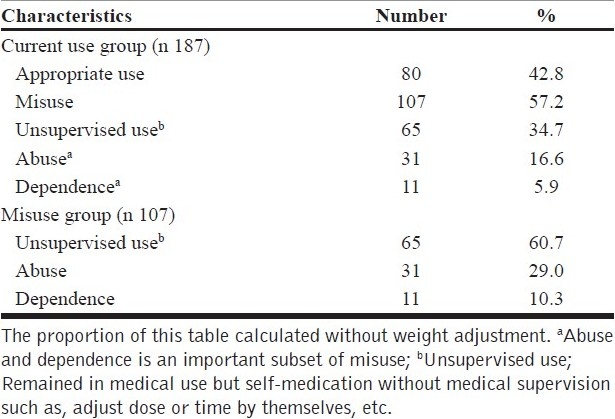Abstract
Context:
Benzodiazepines (BZD) misuse, abuse, and dependence are becoming a new problem in medicine, in Thailand, and the pharmacoepidemiology knowledge is insufficient. The aim of this study is to estimate the prevalence of benzodiazepine use, misuse, abuse, and dependence in the general population of the Ubon Rachathani province, in Thailand.
Aims:
To estimate the prevalence of benzodiazepine use, misuse, abuse, and dependence in the general population.
Settings and Design:
The cross-sectional household survey research was conducted from October 2008 to June 2009, with a target population age of 15 years and above. This took place in Ubon Ratchathani Province, in Thailand.
Materials and Methods:
A total sample size of 2280 were selected from three-stage stratified random sampling. BZD were identified with an accuracy of generic name, trade name, and drug characteristics. The DSM-IV questionnaire was used to define misuse, abuse, and dependence. The accuracy of dependence was interpreted with the help of the judgment of a psychiatric nurse.
Statistical analysis:
For the statistical analyses, prevalence was estimated with weight adjustment, variances estimated by the Teylor Series Linearization method, and interpreted with 95% confidence interval (CI).
Results:
There were 46,805 current users [3.9% (95% CI: 2.2–6.4)], 26,404 misusers [2.2% (95% CI: 1.6–6.2)], 7,203 abusers [0.6% (95% CI: 0.1 - 4.1)], and 2,402 with dependence [0.2% (0.1–9.2)]. When considering the group of current users in this study, 57.2% misusers, 16.6% abusers, and 5.9% with dependence were found, respectively.
Conclusions:
All prevalence of use was higher than previously reported, in Thailand, while more than half of the current users had a behavior of misuse. Surveillance of misuse should be undertaken in the current use. The medical professional should counsel the patient on the harm of misuse and limit the amount of medicine, with necessary dispensing.
Keywords: Abuse, benzodiazepines, dependence, misuse, prevalence
INTRODUCTION
Benzodiazepines (BZD) are psychotropic medicines that are very widely prescribed for anti-anxiety disorders, insomnia, epilepsy, and other psychiatric conditions.[1] BZD misuse is associated with increased risk of tolerance, many adverse drug effects, risk of fall in the elderly, increased motor vehicle accidents, abuse, and dependence.[2,3] Non-medical use of BZD, abuse, and dependence remain critical problems in many countries and are associated with several social and economic consequences.[4]
In Thailand, the pharmacoepidemiology of BZD use currently has been inadequately described. No previous study in Thailand has directly detected BZD or used DSM-IV criteria to interpret its misuse, abuse, and dependence in the general population. The previous study used only omnibus questions, with regard to sleeping pills, tranquilizers or sedative-hypnotics. People might be refused because of did not understand while medicines classification were low accuracy because of misunderstand of people can be occurred, due to many medicine such antihistamine or muscle relaxant also effected to sleep. Thus, the objective of this research is to determine the prevalence of BZD use, misuse, abuse, and dependence, in the Ubon Ratchathani province. The outcome has improved the knowledge related to real problems in BZD utilization at the E-san community level.
MATERIALS AND METHODS
The proposal was reviewed and approved by the Ethical Committee for Human Research of the Faculty of Medicine, Khon Kaen University, Thailand (Ref. Number: HE510507). A household survey research was conducted from October 2008 to June 2009. The setting was Ubon Ratchathani, the second biggest province in the northeastern region of Thailand. The study covered a population age of 15 and above (1,257,719), block / village (3,016), and household (443,886). The sample size had 2,280 participants from 790 individual households, obtained via the three-stage stratified random sampling. The first stage was probability proportional to size (PPS), that is, to select the district, the second stage was simple random sampling (SRS), that is, to select the community-block / village stratified in a municipal and nonmunicipal area, and finally, the third stage was systematic random sampling (SSRS), that is, selected from households in each of the blocks and the willingness of the people (age 15 and above) in each household, to be a participants in this survey.
Data collection and statistics analysis
This study arranged for a sample of BZD, which was found in the province, to compare a type of medicine. The Psychotropic and Narcotics Drug Book (PN-DEX Thailand 2004), which covered all the BZDs from all companies was used to interpret the characteristics of the medicine, its shape, size, trade nameand generic name. Misuse, abuse, and dependence were classified by the DSM-IV criteria (revised version 1994), the international standard criteria from the American Psychiatric Association (APA), and particularly, dependence was interpreted by the judgment of the psychiatric nurse interviewer. All Interviewers of this study were in public health fields, such as, pharmacists, nurses, public health officers, and public health and nursing students. They were trained in the interview technique and their work was monitored by field supervisors. The definition of the current use was, “the use in that month and usage of more than 20 a day or continuous use till the day of the interview”.
For the statistical analyses, prevalence was estimated with weight adjustment (weight adjustment was calculated with the help of the sampling method, health service area, demographic characteristics, and non-response). Variances estimated by the Teylor Series Linearization method,[5] interpreted with 95% CI and statistics were analyzed with program STATA version 10.0.
RESULTS
There were people found, who were current users, approximately 46,805 (3.9% [95% CI: 1.2–6.4]), misuse was 26,404 (2.2% [95% CI: 1.6–6.2]), abuse was 7,203 (0.6% [95% CI: 0.1–4.1]), and dependence was 2,402 (0.2% [95% CI: 0.1–9.2]) [Table 1]. When considered misuse's behaviors particular group of people who were current use. It was found that 42.8% of the current use was appropriate use, 57.2% was misuse, 16.6% was abuse, and dependence was 5.9% [Table 2]. The results showed the characteristics of misuse group as being: 60.7% unsupervised use, 29.0%, abuse, and 10.3% dependence, respectively [Table 2].
Table 1.
Estimated benzodiazepines misuse in Ubon Ratchathani province

Table 2.
Proportion of benzodiazepine misuse group

DISCUSSION
It is difficult to make meaningful comparisons with the previous study, because of the many different methodological approaches. However, the prevalence rate of this study was higher than in the previous study, which studied anxiolytics or sedative-hypnotic use and misuse, in Thailand, and found only 0.2–0.6% current use and 1.58% misuse.[6,7] We have still not found any study in Thailand which indicates the measurement of BZD-dependence on a large scale survey, particularly classified with international standard criteria such as DSM-IV questionnaire, on the general population of Thailand.
When compared with other countries, the prevalence rate of the current use, misuse, and abuse found in this study was less than reports from other developing countries, such as, Brazil, Lebanon, Egypt, and Philippines[8,9] and very much less than that in the developed countries.[10–12] However, in a developing country like Thailand, there was a small prevalence, but it had been increasing, especially in the case of misuse related to other substances, which could have a disproportionately large effect on the overstretched resources.[13] If one focused on the percentage of people who misused, abused, and were dependant on BZDs, in this study, it was low, but the estimated number (point estimated) that had shown obvious problems, in the province, was substantial.
Benzodiazepines are the drugs most frequently misused; there was 57.2% misuse among the current use, which reflected that behavior of misuse occurred easily. While Thai doctors in the community hospital levels realized that they had short assessments, and they accepted that they might be done inappropriately, prescribed on BZD because of workload and increasing of patient.[14] At present, BZDs have been increasing value of using in country continuously[15] as well as still useful and available medical used.[16] Nevertheless, BZD misuse is the main cause to tolerance, adverse drug effect, and dependence. These results also reflected that prevalence of misuse, abuse, and dependence is increasing and becoming a hidden problem, which the local health system should consider.
In conclusion, this study limited its selection to individual households and excluded other residential types such as dormitories, apartments, and military camps, and hence, might have lost some important data. However, BZD use and misuse in E-san communities were higher than in the previous study done in Thailand, and more than a half of current users were misusing it. Therefore, health systems should emphasize on monitoring a patient in the risk group, and control the medicine by limiting the amount of medicine, with necessary dispensing. Moreover, medical professionals should increase the efficiency of recommendation by focusing on the harm of misuse, so that patients realize it and are better aware of the outcome of the misuse.
Acknowledgments
The authors would like to express their sincere thanks to the Public Health Province Office and Primary Care Unit (PCU) for their kindness and encouragement. Research grant was supported by the Office of the Higher Education Commission (OHEC), Thailand.
Footnotes
Source of Support: Office of the Higher Education Commission (OHEC)
Conflict of Interest: None.
REFERENCES
- 1.The world health report. Geneva: WHO; 2007. World Health Organization. [Google Scholar]
- 2.Longo LP, Johnson B. Addiction: Part I.Benzodiazepines-side effects, abuse risk and alternatives. Am Fam Physician. 2000;61:2121–8. [PubMed] [Google Scholar]
- 3.Hemmelgarn B, Suissa S, Huang A, Boivin JF, Pinard G. Benzodiazepine use and the risk of motor vehicle crash in the elderly. JAMA. 1997;278:27–31. [PubMed] [Google Scholar]
- 4.World drug report 2006. United Nation: 2007. United Nation Office on Drug and Crime. [Google Scholar]
- 5.Household surveys sampling in developing and transition countries. United Nation: 2005. Department of Economic and Social Affairs Statistics Division; pp. 447–86. [Google Scholar]
- 6.Assanangkornchai S, Sam-Angsri N, Rerngpongpan S, Edwards JG. Anxiolytic and hypnotic drug misuse in Thailand: Findings from a national household survey. Drug Alcohol Rev. 2010;29:101–11. doi: 10.1111/j.1465-3362.2009.00092.x. [DOI] [PubMed] [Google Scholar]
- 7.Health System Research Instituted Thailand. Report of Thailand health survey 3rd during year 2003-2005. 2007:154–5. [Google Scholar]
- 8.Report of International narcotic control board for 2004. United Nation: 2005. International Narcotics Drug Control Board. [Google Scholar]
- 9.Naja WJ, Pelissolo A, Haddad RS, Baddoura R, Baddoura C. A general population survey on patterns of benzodiazepine use and dependence in Lebanon. Acta Psychiatr Scand. 2000;102:429–31. doi: 10.1034/j.1600-0447.2000.102006429.x. [DOI] [PubMed] [Google Scholar]
- 10.Kassam A, Pattten S. Canadian trend in benzodiazepine and zopiclone use. Can J Pharmacol. 2006;12:e121–7. [Google Scholar]
- 11.Goodwin RD, Hasin DS. Sedative use and misuse in the United States. Addiction. 2002;97:555–62. doi: 10.1046/j.1360-0443.2002.00098.x. [DOI] [PubMed] [Google Scholar]
- 12.Ohayon MM, Lader MH. Use of psychotropic medication in the general population of France, Germany, Italy, and the United Kingdom. J Clin Psychiatry. 2002;63:817–25. doi: 10.4088/jcp.v63n0912. [DOI] [PubMed] [Google Scholar]
- 13.Assanangkornchai S, Chittrakarn S. Situational review of prescription drug abuse between 2000 and 2004. In: Poshyachinda V, Perngparn U, editors. Situational review of substance-related problems in Thailand between 2000 and Bangkok. Thailand: Drug Dependence Research Centres Chulalongkorn University; 2000. pp. 105–36. [Google Scholar]
- 14.Srisurapanont M, Garner P, Critchley J, Wongpakaran N. Benzodiazepine prescribing behaviour and attitudes: A survey among general practitioners practicing in northern Thailand. BMC Fam Pract. 2005;6:27. doi: 10.1186/1471-2296-6-27. [DOI] [PMC free article] [PubMed] [Google Scholar]
- 15.Supply of psychotropic drugs for use in medical practices between 2000–2004. Ministry of Public Health Thailand.; 2005. Office of Food and Drug Administrative Board. [Google Scholar]
- 16.Saipanish R, Zartrungpak S, Silpakit C. A survey of psychotropic drug prescription of general practitioners in primary care settings. Thai J Psychiatric Assoc Thailand. 1998;43:316–24. [Google Scholar]


